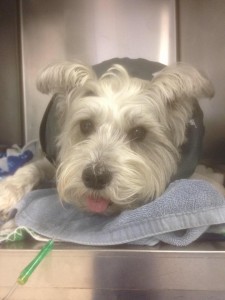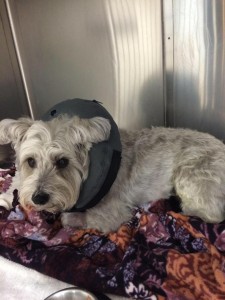About a year ago, our beloved “Office Dog,” Sam, had quite a harrowing post-holiday week. $5000 and 25 staples later, he was on the mend from a gastrotomy (surgically opening up the stomach to remove foreign material) that resulted from a trash bag stealth raid the day after Easter last year. The “post-Easter ingesta” included chicken bones, Kalamata olives, & candy wrappers, among other things. A diagnostic radiograph also revealed an “incidental finding:” Sam had a rather large bladder stone – large enough that a cystotomy (surgically opening up the bladder) was also necessary. Our boy really went through it!
There was no question in my heart as to the necessity of consenting to a surgical gastrotomy to save Sam’s life. The least costly alternative – euthanasia – would have been heartbreaking, and it was a decision I and my partner couldn’t imagine making. VetBilling.com was created for situations just like this one. The huge expense was unexpected and de-stabilizing for us financially. For other pet parents, the same expense could be more than de-stabilizing – it might be downright devastating.
I’ve been through frightening veterinary crises with my animals before, although the last time something like this happened was several years ago. When Sam was facing emergency surgery last week, I was abruptly reminded of what a scary, stressful journey this is for a pet parent. (Thank goodness our veterinarian is sensitive to this. It made a HUGE difference to us that we received texts and pictures throughout different stages of the procedure. That provided us with MAJOR comfort and reassurance.)
This whole thing, though, left me unsettled once again as to the issue of cost. Our company is doing what we can to give pet owners and vets a “go to option” when Care Credit – or other third-party financing – isn’t the right solution. What we’re doing contributes to mitigating the problem of cost vs. care, but it is not a “perfect solution,” which I know doesn’t exist. I think what is bothering me so much about all of this, is that I was smacked in the face by the reality of my consenting to any and every treatment decision – no matter the cost — in hopes that it would save Sam. I know many other pet parents would probably do the same.
I think it’s impossible to be rational in such a situation. And despite the fact that my eyes blurred every time I was shown an updated estimate, I couldn’t imagine giving the order to stop treatment just because the cost had gone way beyond my financial comfort zone. I know I was holding onto the conviction – however flimsy – that I would somehow manage to pay for this. Some way. Truthfully, in the heat of the moment I was far more concerned about Sam’s well-being than about cost. To be completely honest, the fact that my bill was growing larger by the hour was something I coped with by pushing it out of my mind.
I’m willing to bet that the position I was in was no different than that of many pet owners who love their animals and want to resort to extraordinary measures to save them – especially if there’s a very good chance that they can be saved. “Cost be damned!” many of us think at the time. Because we are not so much thinking as we are feeling. In such moments, our hearts are in charge. At least until we see the final bill, and it is time to pay.
I have of course heard the argument that says, “If you can’t afford your vet bill, you shouldn’t have a pet in the first place,” or “you should have an emergency fund in place for these sorts of things.” Well, if the first statement makes sense, then nobody should have children, either. Kids and pets can be expensive, but that doesn’t keep us from having them – or deserving to have them – in our lives. And emergency funds are great – if you live in a perfect world and you only have, say, one medium-sized emergency per year. But for the majority of us, none of this has anything to do with our day-to-day reality. Real life is unpredictable. Pain is inevitable. Having excess cash to deal with it all is improbable.
Pet insurance is helpful, and I do have a policy on Sam. For some reason only about 2% of pet owners in this country have pet insurance – compared to 20 – 30% in Europe. However, even with insurance, pet owners are still faced with the upfront out-of-pocket veterinary expense, and they must wait anywhere from 2 weeks to a month or more to be reimbursed. And the amount of reimbursement (with my policy at least) is limited by maximum allowances on certain tests and procedures. You are typically never going to get back more than 80% of the cost, and often, you don’t even get that much.
[**Note: we have since changed insurance providers and the policy terms are much more favorable. Be sure to do your research on pet insurance. Reimbursement waiting periods are improving, and some providers are now offering direct pay to the veterinarian. Visit Pet Insurance University, or see this informative article from Canine Journal, “Pet Insurance Comparison 2016: Are You Ready to Pay for a Pet Emergency?” Also, check out Nationwide’s newest product, Whole Pet with Wellness here >>> Nationwide Dog Insurance Plans]
The cost of emergency veterinary care concerns me a lot, because even with a VetBilling.com installment payment plan, a $5000 bill for an extreme case of “garbage can gastritis,” spread over six months, results in a payment of $833 each month. A 12 month plan — and many vet practices are hesitant to offer plans this long — yields a monthly payment of $416. There are lots of people whose monthly budget can’t take a hit like that, and what they can comfortably afford on a monthly basis should really be the determining factor in the length of their payment plan. This might mean that they will be making payments for as long as 18 or 24 months, maybe longer. And while the veterinarian doesn’t want to wait that long for their money, a monthly payment amount that the pet owner can handle means there is less risk of falling behind in payments – and a much better chance that the vet will be getting paid in full.
The current, most conventional model for paying for veterinary services is to pay up front, in full, when services are rendered. It just may be that, out of necessity, this will give way to a new model that is more manageable for most pet owners’ budgets. The payment landscape in veterinary medicine may shift, and perhaps in the near future, “paid-in-full” transactions will decline, and installment payments will become more acceptable, at least for the more costly services (although “costly” has a fluid definition, depending on a pet owner’s financial situation.) It’s not an untenable idea, really. Orthodontists, as well as cosmetic surgeons, have been accepting payment this way for a long time – precisely because the cost of these services is prohibitive for many middle and lower income families.
In fact, one of the top five trends in orthodontics in recent years has been the increasing acceptance of non-conventional approaches to fees and payment methods. Chris Bentson, an orthodontic practice management consultant, wrote in a 2012 article for The Dental Tribune that “…use of automatic monthly payment services has greatly increased over the last five years, and some practices are choosing to allow patient contract lengths to extend beyond estimated treatment lengths if certain requirements are met (often either a credit check and/or the insistence of automatic payment method).”
Veterinary costs aren’t going to go down, because we have had (and will continue to have) so many advances in diagnostic and treatment options. But these human-comparable treatments do come with a price tag that can be shockingly high. Part of the reason we’re so shocked by veterinary costs is that, for good or bad, we tend to compare pet health care to human health care.
In human health care, who knows what the full cost of a certain procedure is? We have insurance that takes care of that – if we are lucky enough to have health insurance — and most of us are used to a co-pay. We don’t look at our medical bill and feel overwhelmed by the astronomical amount, because the whole transaction process is really between the doctor/hospital and the insurance company…we don’t have to FACE the actual, total cost and the stress of how we are going to pay for it (depending on your insurance plan. With the rise of High Deductible Health Care Plans in the wake of the Affordable Care Act, this may not be your reality either. And hospitals, like veterinary clinics, are having to shift the way they look at accepting payment as a result.)
While it is incorrect to assume that the human medical payment model should apply to veterinary medicine, it isn’t an uncommon assumption. But wrong assumptions notwithstanding, the issue of rising costs for veterinary care is a real one for both pet owners and vets. And unless a lot more people buy into pet insurance, or have the means and discipline to establish a pet savings account, or veterinary medicine goes the way of managed care (which I don’t think ANYONE wants!), I have to wonder what more any of us can do to address this issue in a way that is fair to all parties: the vet, the pet, and the pet owner. We are working hard to do our part here at VetBilling, by offering an alternative solution that we believe can work well for everyone.
But…when all is said and done, the truth is, this issue isn’t just about money, which is what makes it so darn intractable. This is wrapped up with a lot of emotion too, because it’s about how much we love our pets. We want to hug, kiss, play and snuggle with our furry family member(s) for as long as we can. And there is just no way that anyone can place a dollar amount on that.
That’s why pet owners should be as financially prepared and educated as they possibly can be – and why veterinarians need to re-assess their current model for payment acceptance. We all have to do our part to find more common ground and workable solutions.
Sources: The Dental Tribune, “The business of private practice orthodontics in the United States.” Bentson, Chris. January 2012.
“Nationwide Introduces Whole Pet with Wellness Pet Insurance.” The Canine Chronicle, October 2015.
Recommended reading about pet insurance for pet owners:
“Pet Insurance Comparison 2016: Are You Ready to Pay for a Vet Emergency?” Canine Journal, February 2016.
“Pet Health Insurance Buying Guide.” NAPHIA (North American Pet Health Insurance Association.)
Related posts on this blog:
“No More Blaming and Shaming: What Vets and Pet Parents Need to Understand About Each Other“



